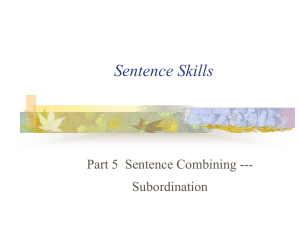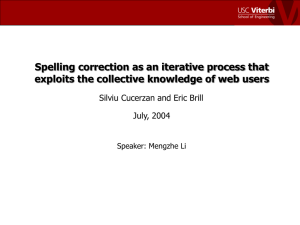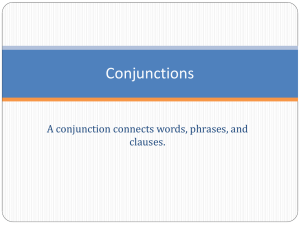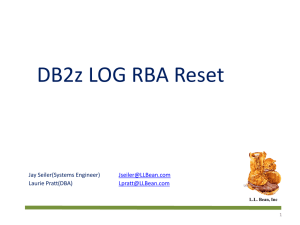EJB Session Beans
advertisement
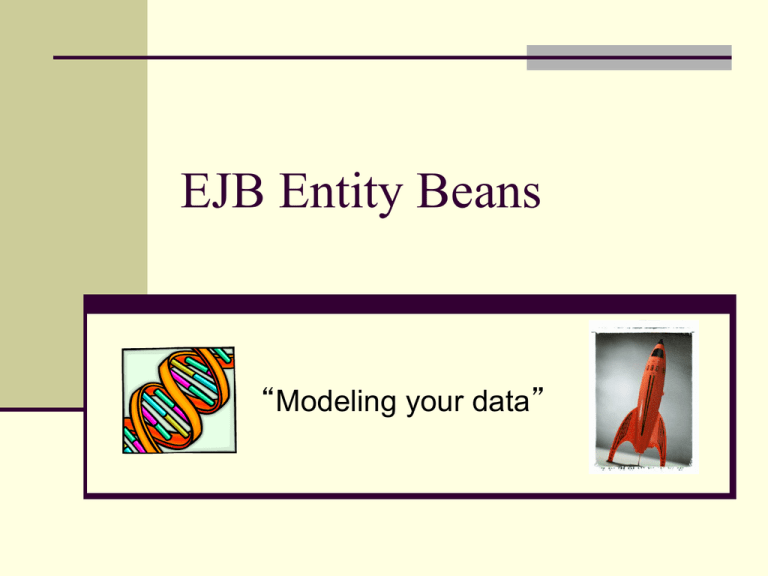
EJB Entity Beans
“Modeling your data”
Model 2 with J2EE EJB’s
Model Two Architecture
View
Control
HTTP
Request
Servlet
Web
Server
Java
Bean
Model
Session
Bean
EJB
Entity
EJB
Java
Bean
<<forward>>
HTTP
Response
JSP
page
Web Container
EJB Container
<<creates>>
Java
Bean
Advantages
Automatic persistence management
Share data in memory
Automatic synchronization to the
database
Simpler to use than JDBC or ADO
Greater scalability, portability,
maintainability, reliability, code re-use
Automatic transaction processing
Guidelines for use
Access Entity EJB ONLY!!! from a
Session EJB
Entity EJBs should represent
developers logical view of data NOT
the physical model in the database.
Relationships View
Order
*
1
Customer
*
1
Item
Use JDBC To Access Data
Class.forName("org.gjt.mm.mysql.Driver"); // load jdbc driver classes
String url = "jdbc:mysql://localhost/northwind";
connection = DriverManager.getConnection(url, "USERNAME", ”PASSWORD");
statement = connection.createStatement();
String sql = "SELECT C.*, O.*, I.* " +
"FROM Customer C INNER JOIN Orders O INNER JOIN Items I " +
"ON C.customerId = O.FK_CustomerId " +
"ON O.FK_ItemId = I.ItemId";
ResultSet resultSet = statement.executeQuery("SELECT * from customers");
while( resultSet.next() ) {
String companyName = resultSet.getString( "CompanyName" );
System.out.printlin("\nCompanyName = " + companyName;)
}
Object Oriented View
Customer
Order
Item
Order
Item
Order
Item
Object Oriented View
public class Customer implements Serializable {
private String name;
…
private ArrayList<Order>
private ArrayList<Order> orders;
orders;
public Customer() {
}
public getName() {
return this.name;
}
public setName(String name) {
this.name = name;
}
publicgetOrders()
getOrders(){ {
public
this.orders;
returnreturn
this.orders;
}}
public setOrders(ArrayList<Order> orders) {
public setOrders(ArrayList<Order> orders) {
this.orders = orders;
this.orders = orders;
}}
}
Object Oriented View
public class Order implements Serializable {
private long quantity;
…
privateItem
Itemitem;
item;
private
public Order() {
}
public getQuantity() {
return this.quantity;
}
public setQuantity (long quantity) {
this. quantity= quantity;
}
publicgetItem()
getItem(){ {
public
return
this.item;
return
this.item;
}}
public setItem(Item orders) {
public setItem(Item orders) {
this.item = item;
this.item = item;
}}
}
Use Getter/Setters to Data
public class GetChildData {
public double totalOrders (Customer customer) {
double total = 0;
ArrayList<Order>
= customer.getOrders();
ArrayList<Order>
orders =orders
customer.getOrders();
for (Iterator<Order> iterator = orders.iterator(); iterator.hasNext();) {
Order order = (Order) iterator .next();
double
price == order.getItem().getPrice();
order.getItem().getPrice();
double price
double extendedPrice = order.getQuantity() * price;
total += extendedPrice;
}
return total;
}
}
Insert object into Datastore
public void addBranch() {
// create a branch java bean
Branch branch = new Branch();
branch.setName(“Bank of Nauvoo”);
branch.setPhone(“203-356-1426”);
// inserts a branch into the database
entityManager.persist(branch);
}
Update Object in Datastore
public void renameBranch(String branchid, String newName) {
// get branch by its Primary Key from datastore
Branch branch = (Branch) entityManager.find(Branch.class, branchid);
// update the branch
branch.setBranchname(newName);
entityManager.merge(branch);
}
Delete Object from Datastore
public void deleteBranch(String branchid) {
// get branch by its Primary Key from datastore
Branch branch = (Branch) entityManager.find(Branch.class, branchid);
// Delete the branch
entityManager.remove(branch);
}
Query Object/s from Datastore
public Collection<Branch> getBranches(String name){
// Define query prepared statement
String ejbql = "SELECT b FROM Branch b WHERE b.branchname LIKE :branchname”;
// Create query object
Query query = entityManager.createQuery(ejbql);
// Substitute value to search for in prepared statement
query.setParameter("branchname", searchValue);
// Execute query to get list of branches
List<Branch>branches = query.getResultList();
return branches;
}
Entity Bean query language (ejb-ql)
select_clause from_clause [where_clause]
select_clause ::= SELECT [DISTINCT] {identification_variable |
single_valued_path_expression }
single_valued_path_expression ::= {single_valued_navigation |
identification_variable }
.cmp_field | single_valued_navigation }
Examples:
SELECT DISTINCT j
FROM Job AS j
SELECT DISTINCT j. *
FROM JOB as j
Entity Bean query language (ejb-ql)
select_clause from_clause [where_clause]
from_clause ::= {abstract_schema_name | collection_member_declaration}
[AS] identifictation_variable
collection_member_declaration ::= INNER JOIN (collection_valued_path_expression)
collection_valued_path_expression ::= idetification_variable.
[single_valued_cmr_field.]
collection_valued_cmr_field
Entity Bean query language (ejb-ql)
select_clause from_clause [where_clause]
from_clause ::= {abstract_schema_name | collection_member_declaration}
[AS] identifictation_variable
From Examples:
SELECT j
FROM Job AS j
SQL equivalent:
SELECT j.*
FROM Job AS j
Entity Bean query language (ejb-ql)
select_clause from_clause [where_clause]
from_clause ::= {abstract_schema_name | collection_member_declaration}
[AS] identifictation_variable
collection_member_declaration ::= INNER JOIN (collection_valued_path_expression)
collection_valued_path_expression ::= idetification_variable.
[single_valued_cmr_field.]
collection_valued_cmr_field
From Examples:
SELECT s
FROM Job AS j, INNER JOIN j.Skills AS s
SQL equivalent:
SELECT s.*
FROM Job AS j INNER JOIN JobSkill AS s
ON j.FK_skillID = s.skillID
Entity Bean query language (ejb-ql)
select_clause from_clause [where_clause]
Where Examples:
SELECT OBJECT(o)
FROM Customer AS c, INNER JOIN c.orders AS o, INNER JOIN o.items AS I
SQL equivalent:
SELECT C.*, O.*, I.*
FROM Customer C INNER JOIN Orders O INNER JOIN Items I
ON C.customerId = O.FK_CustomerId
ON O.FK_ItemId = I.ItemId







